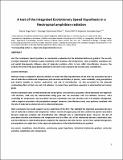Por favor, use este identificador para citar o enlazar a este item:
http://hdl.handle.net/10261/115010COMPARTIR / EXPORTAR:
 SHARE SHARE
 CORE
BASE CORE
BASE
|
|
| Visualizar otros formatos: MARC | Dublin Core | RDF | ORE | MODS | METS | DIDL | DATACITE | |

| Título: | A test of the Integrated Evolutionary Speed Hypothesis in a Neotropical amphibian radiation |
Autor: | Dugo-Cota, Álvaro; Castroviejo-Fisher, Santiago; Vilà, Carles CSIC ORCID; González-Voyer, Alejandro | Palabras clave: | Amphibians Diversification Evolutionary speed hypotehesis Latidudinal biodiversity gradient Molecular evolution Substitution rate Temperatures |
Fecha de publicación: | 2015 | Editor: | John Wiley & Sons | Citación: | Global Ecology and Biogeography (2015) | Resumen: | Aim The Evolutionary Speed Hypothesis is a mechanistic explanation for the latitudinal biodiversity gradient. The recently extended Integrated Evolutionary Speed Hypothesis (IESH) proposes that temperature, water availability, population size and spatial heterogeneity influence rates of molecular evolution which, in turn, affect diversification. However, the evidence for some of the associations predicted by the IESH is not conclusive and in some cases, contradictory. Location Neotropics Methods Using a comparative Bayesian method we tested the following predictions of the IESH: the association between rate of molecular evolution and temperature (and elevation and latitude, as proxies), water availability (using precipitation and relative humidity as proxies), productivity, and rate of diversification. We also accounted for the potential confounding effects of body size and UVB radiation. We tested these predictions separately in mitochondrial and nuclear genes. Results Substitution rates of mitochondrial and nuclear genes were positively associated with temperature and negatively with elevation, while only the mitochondrial coding gene rate was associated with UVB radiation. However, when controlling for temperature, the association between substitution rate and elevation and UVB radiation disappeared, while a negative association with precipitation emerged. Moreover, diversification events were positively correlated with the rate of molecular evolution but only in mitochondrial genes. Main conclusions Our results support two key predictions of the IESH. They highlight the important association between rate of molecular evolution and temperature within a recently diverged group and also confirm the positive association between molecular evolution and diversification rate, although only in mitochondrial genes. However, the lack of association between diversification and temperature and low effect size of the relationship between substitution rates and diversification in mitochondrial genes emphasize the important role other factors, such as time, spatial heterogeneity and population size might have in the origin and maintenance of the latitudinal biodiversity gradient. | Versión del editor: | http://dx.doi.org/10.1111/geb.12318 | URI: | http://hdl.handle.net/10261/115010 | DOI: | 10.1111/geb.12318 |
| Aparece en las colecciones: | (EBD) Artículos |
Ficheros en este ítem:
| Fichero | Descripción | Tamaño | Formato | |
|---|---|---|---|---|
| Dugo-Cota et al 2015 (sin DOI).pdf | 2,7 MB | Adobe PDF |  Visualizar/Abrir |
CORE Recommender
SCOPUSTM
Citations
8
checked on 27-may-2024
WEB OF SCIENCETM
Citations
12
checked on 23-feb-2024
Page view(s)
324
checked on 28-may-2024
Download(s)
497
checked on 28-may-2024
Google ScholarTM
Check
Altmetric
Altmetric
NOTA: Los ítems de Digital.CSIC están protegidos por copyright, con todos los derechos reservados, a menos que se indique lo contrario.
